The Health Education Assets Library (HEAL) is a collection of over 22,000 freely available digital materials for health sciences education. The collection is now housed at the University of Utah J. Willard Marriott Digital Library.
TO
| Title | Description | Subject | Collection | ||
|---|---|---|---|---|---|
| 126 |
 |
Normal pleiomorph and leukemic monomorph bone marrow smear (human) | Stain: May-Grnwald-Giemsa (MGG). In normal bone marrow smear (A) a pleimorph or heterogeneous collection of different cell types (A1-7) can be identified, while in the bone marrow smear of a leukemic patient a single type dominates (in this case lymphoid cells, B-1). | Poja Histology Collection - Blood & Bone Marrow Subset | |
| 127 |
 |
Normal proerythroblasts in bone marrow smear (human) | Stain: May-Grnwald-Giemsa (MGG). The three mounted proerythroblasts are easily recognized by their so called ears i.e., the blue cytoplasmic projections or extensions (arrows). The basophilic cytoplasm as well as the nucleoli point to the blast character of the cells. | Poja Histology Collection - Blood & Bone Marrow Subset | |
| 128 |
 |
Nucleated erythrocytes in peripheral blood smear (bird) | Stain: May-Grnwald-Giemsa (MGG). In contrast to human red blood cells mature erythrocytes of birds contain nuclei (1). (2) Indicates an eosinophilic granulocyte. Inset demonstrates chromatin pattern of the nuclei. | Poja Histology Collection - Blood & Bone Marrow Subset | |
| 129 |
 |
Nucleus expulsion in polychromatic-orthochromatic erythroblasts in bone marrow smear (human) | Stain: May-Grnwald-Giemsa (MGG). The composed pictures show three sequential stages in the final maturation stage of red blood cells. (A) polychromatic erythroblast with a condensed nucleus and an almost acidophilic cytoplasm. (B) the nucleus in the orthochromatic erythroblast is completely condense... | Poja Histology Collection - Blood & Bone Marrow Subset | |
| 130 |
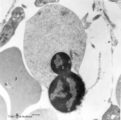 |
Orthochromatic erythroblast (bone marrow, rabbit) | Electron microscopy. The orthochromatic erythroblast (1) or late normoblast shows the early stage of extrusion of the nucleus though the latter appears not yet fully pyknotic. The cytoplasm contains few slender mitochondria (2) as well as scattered clumped polysomes. (3) Part of a reticulocyte. | Poja Histology Collection - Blood & Bone Marrow Subset | |
| 131 |
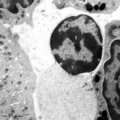 |
Orthochromatic erythroblast (bone marrow, rabbit) | Electron microscopy. The orthochromatic erythroblast or late normoblast is surrounded by young granulocytes (3) and part of a megakaryocyte (2). The cell shows the early stage of extrusion of the nucleus (1) that is already slightly pyknotic. The cytoplasm contains few small mitochondria (arrows) an... | Poja Histology Collection - Blood & Bone Marrow Subset | |
| 132 |
 |
Orthochromatic erythroblast and lymphocyte in bone marrow smear (human) | Stain: May-Grnwald-Giemsa (MGG). The cytoplasm of this orthochromatic erythroblast (2) shows a faint polychromatic tint. The chromatin is arranged in clumps and stains deeply. (2) activated lymphocyte. | Poja Histology Collection - Blood & Bone Marrow Subset | |
| 133 |
 |
Orthochromatic erythroblast in bone marrow smear (human) | Stain: May-Grnwald-Giemsa (MGG). The orthochromatic erythroblast (1) has a dark condensed (pyknotic) nucleus located at one site of the cell, ready for being expulsed from the cell. (2) Erythrocyte. (3) Represents a platelet or thrombocyte. | Poja Histology Collection - Blood & Bone Marrow Subset | |
| 134 |
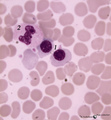 |
Orthochromatic erythroblasts in bone marrow smear (human) | Stain: May-Grnwald-Giemsa (MGG). Two orthochromatic erythroblasts (1) with condensed nuclear chromatin and a transition of cytoplasmic stain towards the color of normal erythrocytes. (2) a segmented neutrophilic granulocyte. | Poja Histology Collection - Blood & Bone Marrow Subset | |
| 135 |
 |
PAS-positively stained neutrophilic granulocytes in bone marrow smear (human) | Stain: Periodic acid-Schiff reaction (PAS). Mature neutrophils (1) have fine positive granules within negatively (un)stained cytoplasm, whereas eosinophils (2) and basophils show a positive cytoplasmic reaction contrasting with the negative granules. In lymphocytes (1) PAS-positive granules are rare... | Poja Histology Collection - Blood & Bone Marrow Subset | |
| 136 |
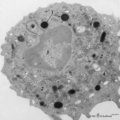 |
Peroxidase activity in neutrophilic granulocyte (peripheral blood, guinea pig) | Electron microscopy (peroxidase reaction with diaminobenzidin staining). The elongated nucleus (3) of this strongly ameboid phagocytic cell has several projections. These nuclear extensions are interconnected by thin heterochromatin strands. The cytoplasm exhibits moderate amounts of organelles, gly... | Poja Histology Collection - Blood & Bone Marrow Subset | |
| 137 |
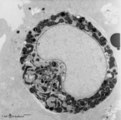 |
Peroxidase activity in neutrophilic myelocyte (postnatal liver, rat) | Electron microscopy (peroxidase reaction with diaminobenzidin staining). An early neutrophilic myelocyte with a large nucleus and well developed organelles, distinct Golgi areas (3) and granules. The Golgi areas, rough endoplasmic reticulum and nuclear membrane stain positively (species-dependent), ... | Poja Histology Collection - Blood & Bone Marrow Subset | |
| 138 |
 |
Peroxidase reaction in reticular cell and myelocytes (postnatal liver, rat) | Electron microscopy (peroxidase reaction with diaminobenzidin staining). The elongated reticular cell (1) shows peroxidase activity within the perinuclear space as well as the rough endoplasmic reticulum (species-dependent). It is surrounded by three eosinophilic myelocytes (2) with a positive react... | Poja Histology Collection - Blood & Bone Marrow Subset | |
| 139 |
 |
Peroxidase staining of granulocytes in peripheral blood smear (human) | Stain: peroxydase staining with DAB (diaminobenzidin). Blood smear showing two strongly positively stained granulocytes and one negative lymphocyte. The (myelo-) peroxidase activity is localized in the granules. | Poja Histology Collection - Blood & Bone Marrow Subset | |
| 140 |
 |
Phagocytosis of latex by neutrophil (peripheral blood, human) | Electron microscopy. The primary function of neutrophilic granulocytes is phagocytosis, ingestion of and destroying microbes or, as shown here, of latex particles. Several electron-light latex particles (1) (with a dense core) are internalized after incubation of free circulating granulocytes with a... | Poja Histology Collection - Blood & Bone Marrow Subset | |
| 141 |
 |
Plasma cell | Scheme electron microscopy. The mature plasma cell or plasmacyte (12-15 m) shows an eccentric nucleus (1) with a characteristic chunky distribution of heterochromatin along the inner nuclear membrane ('spoke-wheel' effect in light microscopy). Juxta-nuclearly an elaborate Golgi area (2) with secreti... | Poja Histology Collection - Blood & Bone Marrow Subset | |
| 142 |
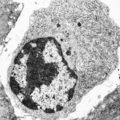 |
Plasma cell (liver, rat) | Electron microscopy. The mature plasma cell or plasmacyte shows an eccentric nucleus with a characteristic chunky distribution of heterochromatin along the inner nuclear membrane (spoke-wheel effect in light microscopy). Juxtanuclearly an elaborate Golgi area (2) (cytocentrum/centrosome). The cytopl... | Poja Histology Collection - Blood & Bone Marrow Subset | |
| 143 |
 |
Plasma cell in bone marrow smear (human) | Stain: May-Grnwald-Giemsa (MGG). (1) A plasma cell with vacuoles (containing Ig), basophilic cytoplasm and a clear halo (Golgi apparatus) in a bone marrow film. (2) represents a young polychromatic erythroblast. (3) neutrophilic myelocyte, and (4) is a cluster of platelets. | Poja Histology Collection - Blood & Bone Marrow Subset | |
| 144 |
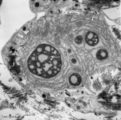 |
Plasma cell with Russell bodies (nose septum, rat) | Electron microscopy. This mature plasma cell exhibits in the cytoplasm dilated rough endoplasmic reticulum (1) filled with electron-grey material as well as electron-dense granules (2) of varying sizes (antibodies). These electron-dense granules are made up of accumulated (crystallin) immunoglobulin... | Poja Histology Collection - Blood & Bone Marrow Subset | |
| 145 |
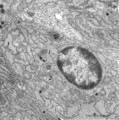 |
Plasma cells (spleen, mouse) | Electron microscopy. The mature plasma cell shows an eccentric nucleus with a characteristic chunky distribution of heterochromatin along the inner nuclear membrane ('spoke-wheel' effect in light microscopy). Juxta-nuclearly an elaborate Golgi area (2) with secretion vacuoles is localized (cytocentr... | Poja Histology Collection - Blood & Bone Marrow Subset | |
| 146 |
 |
Plasma cells in bone marrow smear (human) | Stain: May-Grnwald-Giemsa (MGG). The two plasma cells are mature antibody-producing cells. The basophilic cytoplasm is filled up with rough endoplasmic reticulum (RER). The lighter zone (1) represents the Golgi areas. The nucleus is situated eccentrically and contains strands of condensed chromatin ... | Poja Histology Collection - Blood & Bone Marrow Subset | |
| 147 |
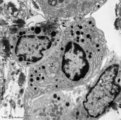 |
Plasma cells with Russell bodies (nose septum, rat) | Electron microscopy. Accumulation of few plasma cells. These mature plasma cells exhibit in their cytoplasm's dilated rough endoplasmic reticula (1) filled with electron-grey material (antibodies) as well as electron-dense granules (3) of varying sizes confirming their secretory activities. (2) indi... | Poja Histology Collection - Blood & Bone Marrow Subset | |
| 148 |
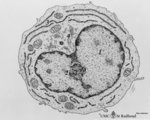 |
Plasmablast | Scheme electron microscopy. This plasmablast (up to 20 μm) shows an indented large nucleus (1) and a distinct nucleolus (2). In addition to free ribosomes long profiles of rough endoplasmic reticulum (RER) (3) are being developed concomitant with Golgi packages (4). The cytoplasm is scanty with few... | Poja Histology Collection - Blood & Bone Marrow Subset | |
| 149 |
 |
Plasmablast in peripheral blood smear (human) | Stain: May-Grnwald-Giemsa (MGG). The oval shaped cell with a slightly excentric nucleus and coarsely clumped chromatin has a basophilic blue cytoplasm in which the Golgi area usually remains unstained (white area). | Poja Histology Collection - Blood & Bone Marrow Subset | |
| 150 |
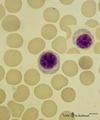 |
Plasmacytoid lymphocytes (activated B cells) in peripheral blood smear (human) | Stain: May-Grnwald-Giemsa (MGG). Two different plasmacytoid lymphocytes or activated young B cells (up to 15 μm) contain a dark-stained nucleus and a slightly basophilic cytoplasm with a kind of a 'nuclear hof' indicating the Golgi area. These cells will develop into plasma cells. | Poja Histology Collection - Blood & Bone Marrow Subset |
